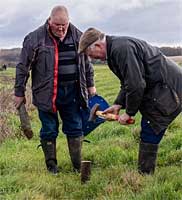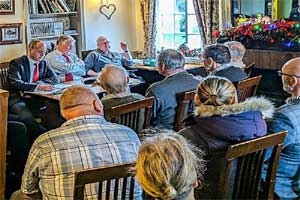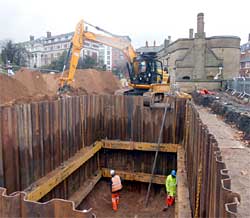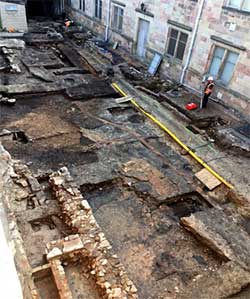News for Spring 2020
An update on Laxton, Nottinghamshire, England’s Last Open Field Village
On 29 January 2020 contracts were finally exchanged for the sale of Laxton by the Crown Estate Commissioners to the Thoresby Estate Trust. The terms and conditions will come into play as of 25 March, i.e. Lady Day, and the day on which rents are traditionally paid. (Ironically, Lady Day was always the occasion in the past when enclosure agreements came into place!)
It has taken many months to sort out the details, and to make sure that the new owners know exactly what they have committed themselves to do. Thorotonians will be aware that Hugh Matheson of the Thoresby estate, who has been the driving force in making this transaction happen, is a firm and committed supporter of Laxton. Several years ago he lectured to the Society on how he saw Laxton evolving, and he now has the opportunity to put this into action. Laxton is, in effect, ‘returning’ to Thoresby, given that the estate originally sold the property to the Ministry of Agriculture in 1951, and they sold it on to the Crown Estate in 1980.
There are likely to be changes at Laxton, largely focussed on developing the heritage of the village for the benefit of visitors, who have always come from both the locality and much further afield. I will keep members informed.
 |
 |
|
| Jury Day. A week prior to the meeting of the Court, shown below, the nominated jurors survey the field which has been in fallow and is about to be drilled for winter wheat. Shown here is the bailiff, Robert Haigh, hammering in one of the stakes. | The Manor Court meeting 2018. Alistair Millar, steward of the manor, appointed by the owners, and a solicitor with Tallent’s, Southwell, is seen here on the left chairing the meeting. To his right are Robert Haigh, the Bailiff and Stuart Rose, Clerk of the Gates and Commons. In front of them various members of the Jury. |
Professor John Beckett
Like a Phoenix from the Ashes – Nottingham Castle re-born
 Excavating rampart deposits in the Outer Bailey of Nottingham Castle in advance of constructing the Visitor Centre. © Trent & Peak Archaeology
Excavating rampart deposits in the Outer Bailey of Nottingham Castle in advance of constructing the Visitor Centre. © Trent & Peak Archaeology Regular readers of the Thoroton Society’s newsletter will know about the Nottingham Castle Transformation Project. The on-going work to transform the 17th-century ducal palace into a 21st-century state-of-the-art visitor destination has been part of the ‘wish-list’ of every history enthusiast in Nottinghamshire for a generation (or more). It is now, finally, becoming a reality.
Proposals for a serious re-structuring of the castle museum began in earnest over a decade ago. Following the success of the City Council in obtaining Heritage Lottery Funding to start developing serious proposals for change, in 2014, I was brought into the project, through the mechanism of an Arts Council England funded post as ‘Curator of Rebellion’ at Nottingham Castle’.
The post, and its evocative title, hint at one of the principal drivers behind the transformation programme. Armed with numerous comments about the disappointing ‘offer’ at the Castle, especially regarding Robin Hood, the City Council decided to make its principal poster-boy for Nottingham the centre-piece of the transformation programme. A purpose-built Robin Hood gallery, covering the old courtyard, which was once used as a staff car park, is now taking shape. The old arches, which were once used to accommodate carriages, have been tastefully converted into usable gallery spaces where visitors will be able to engage in ‘training’ with the long bow or ‘fighting’ Little John. The Robin Hood gallery will offer a different sort of experience – and on a different scale - than was previously available to visitors, thanks in large measure to the size of the project (costing some £30m in total, £14m of it from Heritage Lottery Funding), and the availability of modern interactive technology, including gaming tools and touch-screen interaction. However, the Robin Hood gallery is rooted in the original stories and tales from which the legend grew, and a variety of authorities (including Thoroton’s very own Dr Judith Mills and Dr David Crook) have helped to advise on the gallery’s content, at different stages of the project.
 Nottingham Castle excavations in progress, showing drains and surfaces associated with the Ducal Palace courtyard.
Nottingham Castle excavations in progress, showing drains and surfaces associated with the Ducal Palace courtyard.By contrast, the Rebellion Gallery, with which I have been principally concerned, will examine historic moments when the townspeople of Nottingham faced decisions about whether and how far to act in the pursuit of change, and the consequences which arose out of those actions. The gallery will concentrate on three major episodes from the mid-17th century onwards – the British Civil Wars (the king’s Standard of war, as everyone knows, having been raised at the Castle by Charles I in 1642), the Luddite disturbances of the 1810s, and the Reform Bill Riots of October 1831. Further opportunities to explore contemporary challenges, and our responses to them, will be provided by a changing programme of on-gallery events. The Nottingham Castle Trust, which will be operating the site after completion, will be able to offer a programme of activities, workshops, and lectures, which enlarge upon and support the gallery displays. Fellow Thoroton Council member, Dr Hannah Nicholson, has been working on the Rebellion Gallery as a postdoctoral researcher since 2018; we are both now helping to advise on particular details and acting (rather after the fashion of television historical consultants) as fact-checkers for the scripting and interpretation of the gallery’s exhibits. Mention should also be made of the willing assistance provided by Thoroton’s Transactions editor, Professor Martyn Bennett, who has been a ready source of assistance in respect of the British Civil Wars.
However, Nottingham is much more than its radical reputation. The ‘Power of Art and Making’ is another major theme behind the transformation programme. Nottingham’s famous medieval alabasters, its stone-glaze pottery (previously explored in an exhibition at the Castle which was co-curated by Thoroton’s President, Adrian Henstock), and Nottingham’s iconic Lace Collection, will all find a new, more prominent, home in the re-fashioned Castle. Building on the museum’s unrivalled collections in the field, much thought has been put into the proper interpretation and display of the exhibits, which continue to act as a source of inspiration influencing modern fashion, art and design. The exhibits will hopefully remind visitors of the museum’s origin as a source of inspiration for nineteenth century craftsmen in the city’s lace and textile trades.
The long gallery, the centrepiece of Thomas Chambers Hine’s masterly renovation of the Castle, between 1875 and 1878, will also be restored to its former glory. In the words of the project website, ‘the Long Gallery will play host to hundreds of carefully selected objects, thoughtfully arranged for maximum impact, to inspire and encourage reflection, to enjoy and engage with in a myriad of ways. This gallery reveals what has inspired artists and makers for centuries, be it antiquity, beauty, or the everyday…The gallery mixes fine and decorative arts: paintings, sculptures, drawings, ceramics, textiles, and jewellery’. It will remain an important place to promenade and to be inspired.
Much has lately been made of Nottingham’s unique system of caves which intertwine with the architecture of the Castle rock. In addition to the famous ‘Mortimer’s Hole’, ‘King Richard’s Tower’ and other famous features, visitors will be drawn to particular vantage points, at which they can learn about and explore the history and development of the site. Let us hope it puts paid to the ill-informed comments about Nottingham’s lack of a ‘true’ Castle and leads to a better understanding of how geography, location, and political calculation led not only to the siting of the original Nottingham Castle, at the end of the 11th-century, but to its slighting, six hundred years later.
When Hine’s transformed Castle was re-opened in July 1878, contemporaries described it as having risen like a phoenix from the ashes of the burned-out ruin which the Reform Bill Rioters had left behind. Let us hope that contemporaries are equally impressed when the Castle emerges once more, out of the carcass of scaffolding and protective sheeting which has protected it, during its second transformation.
Richard Gaunt
Tributes to Robert Cecil Woolley Robinson, “Bobby” (6.3.1936 - 30.10.2019)
Melanie Duffill-Jeffs, manager of Bromley House Library, writes that she and the staff were saddened to hear of the passing of Bobby Robinson on the 30th October last year, after a long illness. Bobby was well known to Bromley House as a library member and the husband of former gardener Elizabeth Robinson. In 1999, Bobby was appointed ‘Keeper of the Roof’ at the library, placing upon him the responsibility to carry out occasional inspections of the library’s 250-year-old roof and to advise on any repairs needed. Born in Leicestershire, Bobby grew up in South Africa and spent time in Kenya before moving to Nottingham after the death of his mother. He met Elizabeth not long after this and they celebrated their Golden Wedding Anniversary in August last year. Bobby had a love for history and the natural world. In 2007, he gave a lecture to library members on the topic of beekeeping and was a regular attendee of library events, while his health allowed. Members of the Thoroton Society for over 20 years, they both appreciated the talks and excursions. Remembered as a kind man, Bobby is survived by Elizabeth and his four children.
Elizabeth Robinson writes that in 1920, at the age of twenty, Bobby’s father, Stanley Redvers Robinson, travelled from London to Rhodesia (Zimbabwe) to join the police force there. Just a few years later, Bobby’s mother, Avis Woolley, became a nurse in Rhodesia. Stanley and Avis married in 1931, and went on to have five sons, Bobby being the middle son. In 1935 Avis came back to England with her two sons, unaware that she was expecting a third child - Bobby. She stayed with her sister, Esther, who was the district nurse for the area surrounding Bilstone, Market Bosworth, in Leicestershire. Being a midwife, Esther delivered Bobby and became his godmother aunt. When Bobby was eleven months old the family went back to Rhodesia where Stanley now worked in a copper mine.
At the age of ten Bobby and his two older brothers were sent to boarding school in South Africa, five thousand miles away. The great distance meant that they could only go home twice a year. Other holidays were spent as guests of boys who lived nearer the school. On leaving school, Bobby went to Egerton Agricultural College in Kenya. On graduating he became a farm manager before buying a farm in Kenya with his parents.
After the death of his mother in 1964 Bobby decided there was no future in Kenya and came to Nottingham where his Aunt Esther was living. We met during his first week in England. Bobby was twenty-eight, and I was an eighteen–year-old student at Nottingham College of Art. We married in 1969, when Bobby was about to start his final year at Teachers Training College, Clifton. He started his career teaching science, but an opportunity to teach Environmental Science soon appeared. He went on to be Head of Environmental Science at Wilford Meadows School, a wonderful opportunity to combine his science and farming knowledge. There was a large teaching greenhouse, and Bobby grew bedding plants for all the Nottingham schools. Soon an animal unit was built with chickens, goats, sheep and geese. Bobby and I were beekeepers and he established hives at the school. We joined the Thoroton Society just before its centenary year, and we both appreciated the talks and excursions. Apart from the interesting destinations Bobby loved travelling through the countryside seeing how the farmer’s crops were growing: were they lodged, or doing well? He was so impressed with the fact that the crop was all the same height, understanding the years of research that had brought that about. He loved the English countryside and never regretted moving here. Through the Thoroton Society he learned so much about our history. Perhaps because of his birthplace, Bobby had a particular interest in Richard III. A favourite excursion was to Leicester to see where Richard III’s remains had been discovered, and the site of the Battle of Bosworth Field (by the time of our visit it was understood to have taken place a few miles from the site of the museum).
Bobby died peacefully, at home, with our four children here. He is buried in the meadow at Tithe Green, and an oak tree will be planted in his memory.